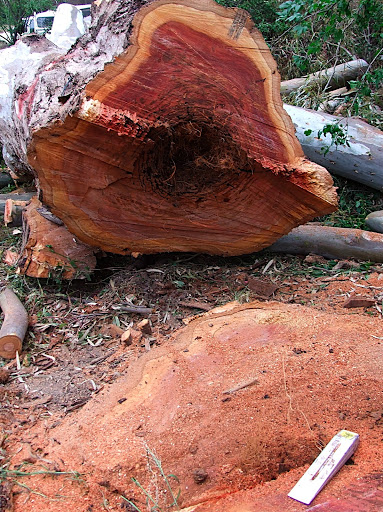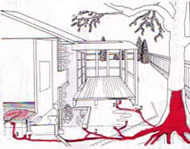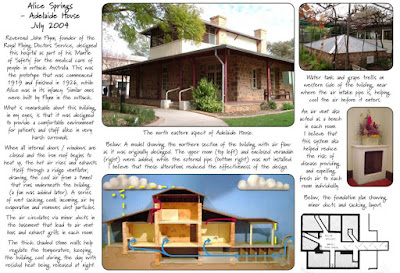Termite resistant design
Principle 6: Produce no waste
Termites cause more damage to Australian houses than fire, floods and storms combined - damage that is not covered by household insurance.
 Termite nest found on house site in trunk of Red Gum after it was felled. Termites can travel 50 - 80m to feed from a nest.
Termite nest found on house site in trunk of Red Gum after it was felled. Termites can travel 50 - 80m to feed from a nest.
 How termites can move from a nest to a house
How termites can move from a nest to a house
 Termite attack in kitchen of original house. The original house had wooden stumps set into the ground with no ant caps and a low clearance where water pooled after heavy rain - a recipe for termite attack.
Termite attack in kitchen of original house. The original house had wooden stumps set into the ground with no ant caps and a low clearance where water pooled after heavy rain - a recipe for termite attack.
Here are ways that you can reduce the chance of termites causing major damage to your home: (from building commission website)
 A termite built mud tube on a bush pole that was set directly into the ground.
A termite built mud tube on a bush pole that was set directly into the ground.
 Fragile termites exposed from under mud tube
Fragile termites exposed from under mud tube
Termite resistant design is something that we have considered right from the start, but I think that it would have been a wise move to consult a termite specialist early on in the process. Most physical termite barriers need to be installed early in the construction phase. By consulting a termite specialist you can be made aware of the current options and techniques used to manage termites, according to your specific needs. Specialists should also be up to date with the current regulations, to ensure that you do what is required to get the 'Termite Treatment Certificate', which is needed in order to get the 'Certificate of Occupancy'.
The building permit notes that the Abdallah House is in an 'area designated as subject to termite infestation' and that protection is required from termites in accordance with Australian Standard 3660.1. Apparently, I must employ both physical and chemical techniques in order to comply with the standards - but in order to find out what the standards are I need to spend $142 to get an electronic copy of the book.
Concrete is an effective barrier to termites, unless it cracks. Cracking in a concrete slab is more likely to happen if it was not prepared properly, which is very common in the age of quick construction - hence underslab termite treatments are often used. Because we compacted the sand fill, vibrated the wet concrete and poured it during the coolest time of the year, we are less likely for the concrete slab to crack - and so fulfill the criterea for a physical barrier according to the Australian standards. If we didn't do that we may have had to drill holes throughout the slab and inject termite treatment - an expensive and messy job, with an unsightly finish. Areas have been left uncovered above the slab insulation for termite inspection.
Concrete stumps with ant caps are another deterrant that we employed. There are chemically treated ant caps that could have been used, had I know before we did the job. Good clearance (400mm) between the ground level and bearers and joists ensure that there is good access for regular inspections as well as allowing the possibility for good ventilation.
Around all areas with ground contact to the house I have dug out a small trench which we are looking at filling with sand mixed with a chemical that will adhere to termites that are in contact with it and infect a termite nest within 15-20m. The chemical is water based and does not smell - and is more expensive than standard treatment which is rather toxic and repels termites rather than infect their nest. Chemical treatments like this need to be replaced every 5 years or so.
Termite treated timber has been used for all framing, this is guaranteed for 25 years. When treated timber is cut and is left exposed it needs to be retreated with an areosol spray.
I was recently told that termite live in acidic conditions, which is why they are so prevalent in Australia. Apparently lime is a good deterant as it is alkaline, which could be a good alternative to harsh chemicals.
 100mm wide x 75mm deep trench dug around concrete stumps to be filled with termite treated sand. Ant caps on top of stumps deter movement up into the house structure.
100mm wide x 75mm deep trench dug around concrete stumps to be filled with termite treated sand. Ant caps on top of stumps deter movement up into the house structure.
Termites cause more damage to Australian houses than fire, floods and storms combined - damage that is not covered by household insurance.
 How termites can move from a nest to a house
How termites can move from a nest to a houseGenerally speaking termites like dark, moist environments and love to eat wood. If you keep timber away from the ground around your house, ensure that water runs away from the house, and keep dark spaces well ventilated then you are off to a good start. It's very important to ensure that you have an inpection area that surrounds any item that is in contact with your home. Inspections should be made every 6-12 months in termite affected areas.
Here are ways that you can reduce the chance of termites causing major damage to your home: (from building commission website)
- Check your property and building regularly for termite activity to reduce the risk of damage
- Plumbing leaks, drainage problems and roof leaks should be addressed promptly, as termites are attracted by damp conditions
- Garden beds should not be built up against walls, as this allows termites an undetectable entry point to the building
- Do not block or cover sub-floor ventilation with garden beds or paving
- Do not stack materials against walls, as this can allow termites to enter without early detection
- Sub floor areas should be well ventilated and vents should not be obstructed
- Storage of cellulose products in the sub floor space should be avoided
- Use termite resistant timber for works around the property, including retaining walls
- Use metal stirrups for verandah and gateposts
- Clean and check timber decks regularly
- Do not build rainwater tanks up against walls, as this may allow termites an undetectable entry point to the building
 A termite built mud tube on a bush pole that was set directly into the ground.
A termite built mud tube on a bush pole that was set directly into the ground. Fragile termites exposed from under mud tube
Fragile termites exposed from under mud tubeThe building permit notes that the Abdallah House is in an 'area designated as subject to termite infestation' and that protection is required from termites in accordance with Australian Standard 3660.1. Apparently, I must employ both physical and chemical techniques in order to comply with the standards - but in order to find out what the standards are I need to spend $142 to get an electronic copy of the book.
Concrete is an effective barrier to termites, unless it cracks. Cracking in a concrete slab is more likely to happen if it was not prepared properly, which is very common in the age of quick construction - hence underslab termite treatments are often used. Because we compacted the sand fill, vibrated the wet concrete and poured it during the coolest time of the year, we are less likely for the concrete slab to crack - and so fulfill the criterea for a physical barrier according to the Australian standards. If we didn't do that we may have had to drill holes throughout the slab and inject termite treatment - an expensive and messy job, with an unsightly finish. Areas have been left uncovered above the slab insulation for termite inspection.
Concrete stumps with ant caps are another deterrant that we employed. There are chemically treated ant caps that could have been used, had I know before we did the job. Good clearance (400mm) between the ground level and bearers and joists ensure that there is good access for regular inspections as well as allowing the possibility for good ventilation.
Around all areas with ground contact to the house I have dug out a small trench which we are looking at filling with sand mixed with a chemical that will adhere to termites that are in contact with it and infect a termite nest within 15-20m. The chemical is water based and does not smell - and is more expensive than standard treatment which is rather toxic and repels termites rather than infect their nest. Chemical treatments like this need to be replaced every 5 years or so.
Termite treated timber has been used for all framing, this is guaranteed for 25 years. When treated timber is cut and is left exposed it needs to be retreated with an areosol spray.
I was recently told that termite live in acidic conditions, which is why they are so prevalent in Australia. Apparently lime is a good deterant as it is alkaline, which could be a good alternative to harsh chemicals.



Comments
Have you seen this system?
http://www.termitetrap.com.au/how_and_why.html
The idea is that you place baits loaded with cardboard (cellulose) around your property that have visible indicators in the top. You inspect the baits regularly, and if you discover termites in one then you inject a poison. The termites will carry this back to their nest and you'll wipe out the whole colony.
It sounds like it'd be a fairly effective and relatively inexpensive way to stay on top of the problem.
What do you reckon?